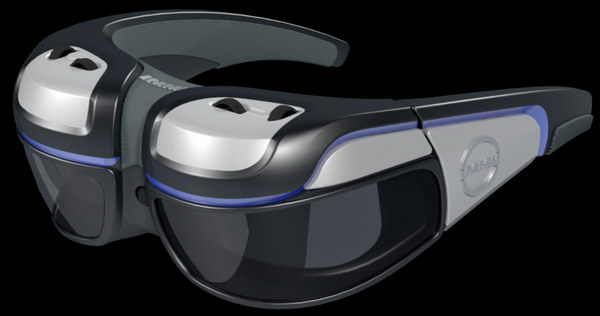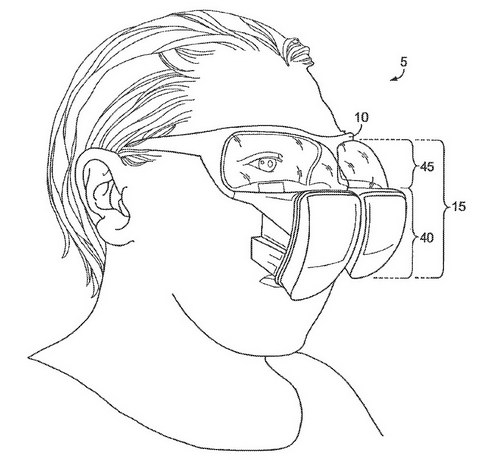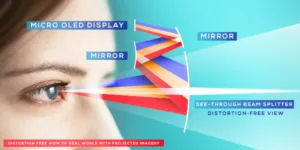Immy Inc. has developed the Immy Neo iC 60 see-through HMD, initially for augmented reality (AR) applications but follow-on units will eventually be usable for virtual reality (VR) applications as well. This unit is based on what Immy calls “Natural Eye Optics” (NEO), an all-reflective optical design similar to what is used in some head-up displays.

As an image source, the iC 60 uses a pair of Sony 0.39” XGA (1024 x 768) OLED microdisplays, one for each eye. There is 100% overlap between the two images so the system can show stereo 3D. Immy has publicly discussed the iC60 HMD since at least 2015 but Douglas Magyari, CEO of Immy, told me the Mark 1 version of the device will be available for pre-order on April 13th, although he would not say when the unit would start shipping. The primary initial market will be industrial and military, plus some focused strategic consumer applications. He said the price of the first 5000 units sold will be $2,000. After that, the price will drop to nearer $1,000, depending on component suppliers. He added the units will actually be made in the US by Immy, a Michigan-based company, and not outsourced.
The Mark 2 version of the iC 60 will be available later in the year. One key difference between the Mark 1 and Mark 2 is the Mark 1 is tethered to its host via a USB-C connection while Mark 2 will be connected wirelessly to the belt-worn CPU/GPU. In addition, Mk. 2 will have improved optics and a more robust set of sensors.
 Immy NEO iC 60 see-through HMD (Image: Immy)
Immy NEO iC 60 see-through HMD (Image: Immy)
Perhaps the thing that sets Immy apart from other HMDs is the optical design. This NEO design is based on an all-reflective system and is subject to three US patents assigned to Immy: US 9,268,139; US 9,250,444; and US 9,151,954. Magyari is named as sole inventor on the ‘139 and ‘444 patents and Salvatore Vilardi, V.P. of Product Development at Immy, is named as his co-inventor on the ‘954 patent. There also have been patents granted in Japan and Mexico.
IOptical design of the Immy iC 60 (Source: Immy)
This optical design, which uses an emissive display plus three thin mirrors, has numerous advantages and has often been used on head up display (HUD) systems. Except for the collection of the light from the lambertian display by the first mirror, it can be very efficient. Karl Guttag tells me it has roughly a 4x optical efficiency advantage over comparable “Birdbath” optical designs used in some other HMDs. It is, potentially at least, very high resolution and low distortion.
Since the optical elements are all thin and air spaced, it is potentially light weight. As there is nothing special in the beamsplitter at the location of the superimposed AR information, the see-through image is not degraded in the critical foveal region, where eye resolution is the highest. With the microdisplay turned off, the see-through image looks just like it would look through a set of sunglasses. While the current designs have an AR field of view (FOV) of 60°, the design is said to have the potential for a 135° FOV.
There is one big disadvantage of the design, however, it is relatively bulky. The air-spaced optical elements require, well, air between them. While Immy has done a good job of minimizing this bulk compared to their original designs, it is still a factor and no one would ever mistake this HMD for a pair of ordinary sunglasses.
 Original Immy Optical Layout (Source: US 9,151,954 Figure 1)
Original Immy Optical Layout (Source: US 9,151,954 Figure 1)
Magyari says Immy has already gone beyond the Mark 1 and Mark 2 designs and is working on a 1080p (1920 x 1080) version that replaces the 0.39” Sony XGA OLED microdisplay with 7.8µm pixels with a 0.23” display based on MicroLED technology (which he calls iLED) that will have 3µm pixels. In the iC 60, with 1024 horizontal pixels in a 60° FOV, each pixel subtends 3.5 arc-minutes, compared to the nominal limit of human resolution of 1 arc-minute. This is good, better than most dedicated HMDs and much better than any HMD based on a smartphone display, but the pixels should still be visible.
I haven’t seen an Immy unit so I can’t say for sure. However, Tal Blevins saw one at the recent Game Developers Conference in San Francisco and said, “While just an engineering build at this point, the test unit I tried was very light. I was impressed by how bright the colors were and the sharpness of the picture. The 60-degree field of view was also noticeably wider than both the Hololens and Meta 2, and gave a more natural visual feel to the experience.”
The MicroLED version of the design will bring several important things to the Immy HMD. First, the 1920 pixels horizontally spread across a 60° FOV will give 1.9 arc-minutes per pixel, near the limit of human vision and probably close enough to make the pixels effectively invisible.
Second, the MicroLED display will be orders of magnitude brighter than the OLED unit. Typically, OLED microdisplays are ~500 cd/m² while people are talking 10,000 cd/m² and more for MicroLED display brightnesses. This higher luminance will enable a brighter image, even given the smaller microdisplay size and higher required magnification. This will, in turn, allow the use of the see-through HMD in higher ambient light conditions, e.g. outdoors in direct sunlight, and still get acceptable visibility for the AR information.
Another advantage is the MicroLED display is (expected to be) more efficient than the Sony OLED microdisplay, reducing power consumption. Of course, if the MicroLED is driven at 10,000 cd/m², it is likely to consume more total power than the OLED at 500 cd/m², so this advantage may not be apparent if the HMD is used where the full brightness is needed.
Finally, the MicroLED display is smaller. This should allow a still more compact optical system compared to the current iC 60 Mark 1 or Mark 2.
Magyari said he expected to get working samples of the MicroLED (iLED) display in November or December of 2017. He declined to identify the vendor. I would guess that there will be at least a year of development work both at Immy and at the microdisplay supplier, so I wouldn’t expect product before Q1 2019 at the earliest.
BTW, I asked Magyari where “Immy” came from. He told me, “It’s a made-up word to simplify the phrase ‘Immersive Imager’, which is a mouthful. All of these headworn viewers are immersive imagers, so now they’re simply Immy’s.” –Matthew Brennesholtz

